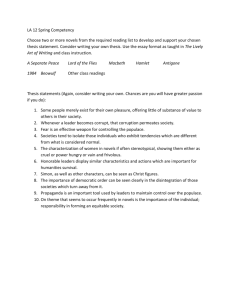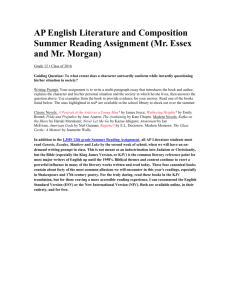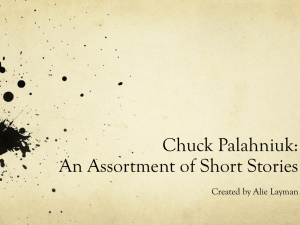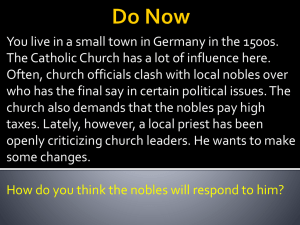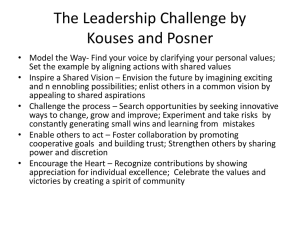thompsonOxford Paper Summer 2009
advertisement
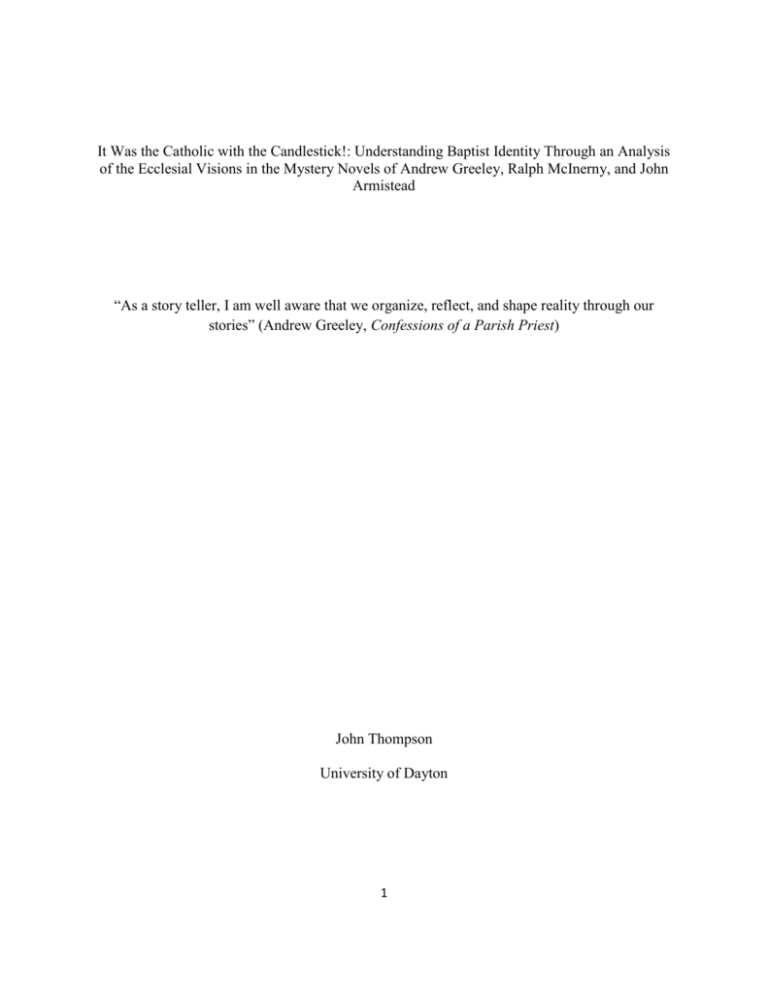
It Was the Catholic with the Candlestick!: Understanding Baptist Identity Through an Analysis of the Ecclesial Visions in the Mystery Novels of Andrew Greeley, Ralph McInerny, and John Armistead “As a story teller, I am well aware that we organize, reflect, and shape reality through our stories” (Andrew Greeley, Confessions of a Parish Priest) John Thompson University of Dayton 1 I. Introduction In Grace and Necessity, Rowan Williams argues that all art presupposes a theology.1 In the novels of Catholic writers Ralph McInerny, Andrew Greeley, as well as the Baptist writer John Armistead this thesis is evident. In this paper I will examine the implicit theology contained within and argued throughout the mystery novels of Ralph McInerny, Andrew Greeley, and John Armistead. Three writers who are deliberately and defiantly Christian.2 What I hope to demonstrate is that, besides providing thrills and excitement, each of these authors and their respective novels contain implicit theologies, what I refer to as “ecclesial visions.”3 In examining these ecclesial visions a view of each author’s notion of Christian identity becomes apparent. This paper develops its analysis in three sections: 1) The Scene of the Crime: A Framework of American Catholic Literature and the Mystery Novel; 2) The Suspects: Authors and Characters in the Mystery Novels of Ralph McInerny and Andrew Greeley and John Armistead; and 3) The Lineup: Identity, Distinctions, and Ecclesial Vision. What I hope to show is that the novels of Ralph McInerny and Andrew Greeley help us approach Armistead’s novels and the understanding of Baptist identity contained within them. 1 Rowan Williams, Grace and Necessity (Continuum, 2005). On this account, T. S. Elliot actually discounts writers who are religious from any discussion of religion and literature. T. S. Elliot’s primary example of this type of literature is G. K. Chesterton and his “Father Brown character.” T. S. Elliot claims that he enjoys these stories very much but they cannot be thought of as objects of literary criticism which seeks to understand the connection between religion and literature (T. S. Elliot, “Religion and Literature,” in Selected Prose of T. S. Elliot, ed. Frank Kermode (New York: Harvest, 1975), 99-100). 3 McInerny’s and Greeley’s novels have been examined in a multiplicity of ways. For example, Stanley Hauerwas examines how McInerny’s novels (and Murder Mysteries in general) provide excellent examples of practical ethical reasoning (see “McInerny Did It,” in A Better Hope (Grand Rapids, MI: Brazos, 2000), 201-210). 2 2 II. The Scene of the Crime: A Framework of American Catholic Literature and the Mystery Novel Literature is not written in a vacuum. Each literary work of art is situated within a specific social and cultural milieu that influences and perhaps even catalyzes its production. American Catholic Literature is no different. However, it is not just the culture that influences American Catholic Literature but also the novelist’s own view of the reality. Una Cadegan, associate professor in the Department of History and director of the American studies program at the University of Dayton, defines Catholic Literature as works that are “deeply Catholic in the way they depict human nature and created reality.”4 Her article goes on to survey a rich tradition of American Catholic authors from past Catholic authors such as Mary Anne Madden (18201903), Kathleen Thompson Norris (1880-1966, F. Scott Fitzgerald (1896-1940), Ernest Hemingway (1899-1961), Walker Percy (1916-1990) and Flannery O’Connor (1925-1964) to present ones such as Anne Rice (1941 to present), Ron Hansen (1947 to present), Mary Gordon (1949 to present), and Alice McDermott (1953 to present). The Catholic mystery novel is situated within this rich history. Like other examples of Catholic literature, mystery novels by Catholic authors are influenced by their faith which transforms the vision of reality contained within them. While there are multiple representatives, the best known is G. K. Chesterton. Both Greeley and McInerny give credit to the work of G. K. Chesterton as inspiration for their mystery novels.5 While an indepth analysis of Chesterton’s Una Cadegan, “U. S. Catholic Literature,” University of Dayton Catechist Formation Program, Catechist Magazine (May/April 2001): 44-53. 5 For example, McInerny writes, “Chesterton did it for me….In my first year at the minor seminary of the Archidocese of St. Paul, an upperclassmen handed me Maisie Ward’s Life of Chesterton, saying that he thought I might like it. The book was almost as big as I was, and I was flattered by the thought that I moved in the same 4 3 Father Brown novels are beyond the scope of this paper, a brief analysis of Father Brown’s characteristic method of crime solving will help us understand the characters of Father Dowling and Bishop Ryan as well as the “ecclesial visions” contained within their stories Father Brown is the main character in fifty-two Chesterton’s short stories, later compiled into five books. Father Brown is a largely common priest “formerly of Cobhole in Essex and now working in London” who is noticeably bright and witty.6 What makes Father Brown distinct from other fictional detectives such as Sherlock Holmes is his intuitive rather than deductive method of crime solving and his focus upon anthropology. In “The Secret of Father Brown” Father Brown describes his method: You see, I had murdered them all myself…I had planned out each of the crimes very carefully. I had thought out exactly how a thing like that could be done, and in what style or state of mind a man could really do it. And when I was quite sure that I felt exactly like the murderer myself, of course I knew who he was.7 In other stories it becomes apparent that this intuitive ability is shaped by Father Brown’s experience as a priest and confessor. In “The Blue Cross,” when asked by the notorious French criminal Flambeau, who has been masquerading as a priest, how he knew of all sorts of criminal “horrors,” Father Brown responds, “Has it never struck you that a man who does next to nothing but hear men’s real sins is not likely to be wholly unaware of human evil?” Father Brown later states his reason for knowing that Flambeau was an imposter: “You attacked reason. It’s bad theology. This intuitive method displays what it is that distinguishes Chesterton’s (as well as McInerny and Greeley’s) characters as Catholic namely their vision of reality. Father Brown mental universe as young men who needed to shave. I spent hours reading, enthralled in Chesterton. I knew then I wanted to do the sort of thing he did” (Ralph McInerny, “On Being a Catholic Writer,” Crisis 13, no. 11 (December 1995): 32-35. 6 In one of the short stories, Father Brown refers to himself as a man who “could paraphrase any page of Aquinas.” 7 G. K. Chesterton, Secret of Father Brown (London:House of Stratus, 2008), 121. 4 solves his crimes through a reasoning process more concerned with spiritual and anthropological truths than scientific details.8 In other words, he is a sleuth influenced and formed in a particular way of seeing the world, a vision of reality. This vision of reality is connected with the characteristics possessed by Father Brown as well as the characters in the novels of Ralph McInerny, Andrew Greeley, and John Armistead. Before discussing in further detail the ecclesial visions in the section below I will give a brief summary and analysis of the author’s and their characters. III. The Suspects: Authors and Characters in the Mystery Novels of Ralph McInerny and Andrew Greeley and John Armistead Before analyzing the ecclesial visions contained within their novels, a brief sketch of Ralph McInerny, Andrew Greeley, and James Armistead is necessary. In the following sections I will give an introduction of each of these authors as well as the major characters of their novels (Father Dowling, Bishop Blackie Ryan, and Sheriff Grover Bramlett). Besides being a mere summary, I will attempt to analyze particular characteristics of the main characters that are important to understanding the ecclesial visions (or implicit theologies) contained in the novels. A. Ralph McInerny and Father Dowling Ralph McInerny was born in Minneapolis. Early in his life he had intended to become a priest but instead became a philospher and teacher receiving a BA from St Paul's Seminary, Minnesota, an MA from the University of Minnesota, and a PhD in philosophy from Laval University, Quebec. After teaching stints at Creighton University and Rome, McInerny was 8 Some interpreters point out that this makes Father Brown an almost equal counterbalance with Arthur Conan Doyle’s Sherlock Holmes. 5 appointed Professor of Philosophy at Notre Dame University in 1969 where he has taught for more than 50 years, and where he became director of the Jacques Maritain Center. He has published a large number of books on religious subjects (he is a recognised authority on St Thomas Aquinas and Natural Law), and his seventy novels include twenty-nine that feature Father Dowling In McInerny’s first Father Brown mystery, Her Death of a Cold, we are introduced to Father Roger Dowling, a Catholic priest who worked for more than fifteen years on the Chicago Archdiocesan Marriage Council as a canon lawyer dealing with all those cases “paraded past the canonical eye in quest of an annulment.” He had a doctorate in canon law and "been on the upper rungs of the clerical ladder of success" and so one of "the small group from which the bishops of the future are chosen.” But this was not to be. “Eventually the repetition, the law's delay, the notquite-honesty on all sides and the relative helplessness of the tribunal, outpost of as it was of a bureaucracy thousands of miles away where the truly difficult, truly interesting cases must be sent for decision - eventually all these took toll.” He had met too many unhappy people whom he could not help. His hair had “thinned, revealing the narrow domed skull that was the trepository of so much borrowed human grief. Like many tall people, he had early acquired a slight stoop and, as he grew older, sadder if not wiser, his posture suggested he was ready to shoulder whatever tragedy was brought to him.” 6 Deeply affected by all this, Dowling had gradually taken to drink.9 But with help from a sanatorium doctor, who told him that his drinking was “only a symptom of the fact that you hated your work,” he quit drinking and explains to the chancellor, “I have always wanted a parish.” Aged almost fifty, Father Brown is happy to accept the downtown and neglected parish of St Hilary's in Fox River, where the pastor had died several months before. It was “a parish that had fallen on evil days, the interstates having isolated the parish plant in a triangle bordered by incessant noise.” There were few young people left in the parish. The school was closed and had become instead a parish center for old people. Dowling had really been sent there “as a species of punishment.” But he gets to love pastoral life there and eventually regains his sense of vocation, much helped by meeting up again with Phil Keegan, an old friend and committed Catholic, and now chief of detectives. McInerny writes that Dowling “was unmistakably a priest. Whatever the reluctance of his fellow priests to appear in the traditional priestly garb, Roger Dowling always wore a black suit, rabat, and Roman collar.” He is a real traditionalist, disliking the way that modern liturgists had “pursued their off-Broadway antics", but he is a kindly, patient man: “a quiet pipe-smoking pensive priest". Even if he was “not happy about all the changes in Holy Mother Church .... he had no doubt that she would muddle through.” Reflecting upon why he made Dowling a recovering alcoholic, McInerny writes, “I began to have a notion of what Father Dowling was like. As a priest he might seem to be observing everything from a lofty point of view, so I made him a recovered alcoholic chastened by what he had been through and a better man and priest because of it” (McInerny, I Alone, 72). 9 7 From this early introduction we meet a complicated man who solves crimes while “shepherding his parish as God has called him.” There are numerous characteristics of Father Dowling that stand out as McInerny’s novels progress, but there are two particularly important ones in distinguishing Father Dowling (as well as McInerny’s characters) as particularly Catholic: confession as method and forgiveness.10 McInerny himself notes that confession and forgiveness are what “explain Father Dowling interest in murder and mayhem.”11 These two characteristics of confession as method and forgiveness are intimately connected in both plot and main character in the father Dowling mysteries. While these two characteristics of both character and novel are prevalent throughout the Father Dowling novels for the sake of brevity I will give a few examples of each. Rather than separate the two I will consider them as two parts of a whole. In his seventh Father Dowling novel, Loss of Patients (1982), McInerny explains Father Dowling’s motivation in solving murder mysteries. We are told that Dowling’s aim in tracking down murderers “was to be a means God used to dispense His mercy.” Rather than merely solving the crime, it is the condition of the murderer’s soul that interest Dowling most: “God pursued him, not with an eye to punishment, but in order to forgive and reconcile.” Once the murderer has been caught and his punishment assured, Dowling points out that “[the murderer] was that much readier for mercy…Not from humanity…But there is One who is the union of mercy and justice and it was before His bar that he hoped to bring him.” 10 In an essay on Catholic Mystery Novels, McInerny observes that most readers are content to use rather superficial criteria to distinguish Catholic mysteries from those that are not—for example, Catholic mysteries require the presence of a priest or a nun. Yet commenting on his own work, which obviously accepts to convention of having a priest or a nun as the detective, McInerny notes, “I wanted a priest to represent the contrast of sin and forgiveness and a cop, Captain Keegan, to represent that between crime and punishment” (Ralph McInerny, “Saints Preserve Us: The Catholic Mystery,” in The Fine Art of Murder: The Mystery Reader’s Indispensible Companion, ed. Ed Gorman, Martin Greenberg, Larry Segriff, with Jon Breen (New York: Carroll and Graff, 1993), 149). 11 Ralph McInerny, “On Being a Catholic Writer,” Crisis 13, no. 11 (December 1995): 35. 8 Dowling means of catching the murderer is tied to this desire to give absolution. In each of the crimes he solves, Dowling identifies the murderer more by his ability to get people to talk to him than by any particular skill in deduction. Like Father Brown’s intuitive method Dowling’s method is linked with his role as priest, specifically in receiving confessions. In Abracadaver (1989) as well as Ash Wednesday (2008) Father Dowling recounts that it is his role as priest that best suits him to solve crime, specifically, “through hearing confessions [Dowling] is well-placed to solve crime…it is the language of the penitent that often gives them away.” This ostensible practice of confession (Dowling hearing the confession of the criminal, sometimes without the criminal recognizing he/she is confessing) is the connection to Dowling’s understanding of forgiveness as the ultimate end of solving a murder. Examples of Dowling’s desire to grant absolution to the criminal through confession are numerous. One example is found in the story “Hic Jacet,” a Latin phrase meaning “Here he lies.” Dowling, like his other cases, solves the crime and confronts the murderer. Rather than turning to him in, Father Dowling grants the criminal absolution. While Father Dowling does indeed solve the crime, what separates him from other fictional detectives is that while the crime is solved through reason, Father Dowling injects forgiveness as grace into the criminal justicesystem. In another story, “Anathema Sits,” Dowling could easily be replaced by a “secular” detective (Dowling’s role as priest is minimal in the story), except for the absolution of the murder at the end. This offering of forgiveness extends beyond the criminals to other characters in the Father Dowling stories. In the short-story “The Dunne Deal” Father Dowling presides over a series of Masses for the repose of the soul of Fergus Dunne. While this at face value is not an 9 important detail, it becomes important when it is revealed that Fergus Dunne deceived friends and family about his life specifically into believing he was a war hero.12 These lies were responsible for the mystery surrounding various thefts of valuables from the Dunne family. B. Andrew Greeley and Bishop Blackie Ryan The Rev Dr Andrew Greeley is an Irish-American “liberally-minded” Roman Catholic priest (ordained in 1954), who trained as a sociologist and taught at the University of Chicago, becoming a very well known author and journalist. He is the author of over fifty best-selling novels and more than 100 works of non-fiction, including two volumes of autobiography. Currently, a retired Professor of Sociology at the University of Arizona and a Research Associate with the National Opinion Research Center at the University of Chicago, Greeley describes himself on his own website as “one of America's most popular and trusted storytellers” and a “respected scholar whose current research focuses on the Sociology of Religion.” He also has a special interest in the celibacy of priests, the ordination of women, and the sexual behavior of Catholics. His views sometimes arouse vitriolic responses from other Catholics who accuse him of producing near-pornographic novels, and resent the way he is often approached by the media to represent Catholic views. There are seventeen books in the Father Blackie Ryan series, although a younger Blackie also appeared in other book, including Virgin and Martyr (1985), Angels of September (1986), Rite of Spring (1987) and St Valentine's Night (1989). 10 The Reverend Monsignor John Blackwood Ryan S.T.L., Ph.D. is more often known as Father (or later Bishop, then Archbishop ) Blackie Ryan, and keeps telling people to “Call me Blackie” (an echo of “Call me Ishmael” at the start of Moby Dick). In the first book of the Blackie Ryan series, Happy Are the Meek, he is aged just past 40, and is Rector of Holy Name Cathedral in Chicago, where “I administer, badly, I admit, a large and variegated parish.” Born in 1945 and ordained a priest in 1970, Blackie had been created Domestic Prelate (Monsignor) in 1983. An author himself, Blackie Ryan is the author of such unlikely books as Truth in William James: An Irishman's Best Guess (1985) and James Joyce Catholic Theologian (1992). He regards himself as both priest and philosopher.13 Blackie Ryan claims to be “the most innocuous and least romantic of men.”14 He is “short and rather dumpy. Unhandsome, with thin grizzled hair, a high forehead, and near-sighted blue eyes blinking behind thick, rimless glasses, meek-voiced, and mild-mannered.” He's a “cherubic little man with .... a Father Brown manner that is not altogether accidental.” He has been known to call himself “The poor man's Father Brown.” But, behind this outer appearance, there is a much tougher character, “a really scary man,” who can fight off opponents if he has to. As well as his cardinal archbishop describing him as having "one of the finest minds in the Catholic church. “He's almost always right,” he says. “Seldom in error and never in doubt.” Andrew Greeley writes that the Blackie Ryan stories “are the major accomplishment of my life as a priest.”15 Why does he feel this way? 13 He feels this way because he sees Bishop Because of the similar characteristics between author and character, several reviewers have argued that Blackie Ryan is the fictional representative of Andrew Greeley. A charge which Greeley repeatedly denies. 14 “You could enter an elevator I was riding and not even notice I was there. Indeed I am often the little man who wasn't there. Occasionally I even manage to be not there again today." 15 Andrew Greeley, Furthermore! Memories of a Parish Priest (New York: Forge, 1999), 149. 11 Blackie Ryan as “a metaphor for the Church at its best…When Ryan decides that you need help, you are helped…whether you want to be helped or not.” For Greeley, Blackie “represents the priesthood at its best…its wit and determination, its learning and its openness, its insight and its kindness. Not all priests are as clever or as gifted, but if there were more priests as sensitive and as sympathetic as Blackie, the Church would be in much better shape than it currently is, no matter how many semi-literates are in leadership positions and how much slime oozes out of the Papal Nunciature on Massachusetts Avenue in Washington.”16 Blackie Ryan is an excellent priest because of his characteristics of sensitivity, “a priestly sensitivity that leads him to get involved in the investigation of crime in the life of others.”17 It is this sensitivity that, like Dowling’s characteristics of confession as method and forgiveness, help identify him as a Catholic detective. Blackie Ryan’s sensitivity is recognized in how he becomes involved in various criminal investigations. Unlike other detectives such as Father Brown who often merely stumbles onto the scene of a crime, Blackie Ryan always comes into a case at the behest of a relative, a friend, or a client of his family. In his first appearance in Virgin and Martyr, he comes to the aid of his cousin Mary Kate who asks him to investigate the “death” of another cousin, Catherine Collins. In St. Valentines Night, Cornellus O’Connor, a friend of Catherine Collins, consults Blackie Ryan in trying to solve the murder of the husband of Collins’ lover. In Rite of Spring, Brendan, who once dated Blackie’s sister, Eileen Ryan, seeks the priest’s help. This pattern of aid continues in Happy Are Ibid., 188; “He preaches; he hears confessions; he greets his congregants in back of church after Mass; he counsels; he keeps records; he officiates at weddings, funerals, and baptisms; he visits hospitals and goes to cemeteries; he hangs around with teenagers and little kids; he tolerates the oddities of his curates; he prays regularly with such appealing fashion that one suspects that even God may think he is cute” (Ibid., 184). 17 Personal correspondence with Andrew Greeley via email. 16 12 the Meek in which Blackie agrees to investigate the life and death of a possible Satan-worshipper in order to bring the man’s new lover back to the Church.18 Blackie Ryan’s sensitivity is not a mere good-will toward his fellow man, but is born from the cloth. “His compassion is the compassion of the one he serves toward the parish he serves.”19 In other words Blackie Ryan’s sensitivity toward others is a priestly sensitivity, a sensitivity that illustrates the ecclesial vision contained in Greeley’s novels. C. John Armistead and Sheriff Bramlett/Clergy John Armistead, an ordained Baptist minister, is an award-winning author, artist, and journalist. He earned a B.A. from Mississippi College in 1963 and a Master of Divinity from Golden Gate Baptist Theological Seminary in 1966. In 1975, he received the D.Min. degree from New Orleans Baptist Theological Seminary. After receiving his Doctor of Ministry, Armistead spent the next twenty-nine years serving as at various Baptist churches. His career as a Baptist minister took him to Hawaii from 1975 to 1979, when he moved to Tupelo, Mississippi, abd became pastor at Calvary Baptist Church, a position he held until 1994. At the age of 52, he published his first novel, A Legacy of Vengeance. When told by a deacon at his church that if he published another book, he was “out of here,” Armistead resigned from the church and took a position as a religion journalist for the Tupelo Daily Journal newspaper. In 1995, Armistead published A Homecoming for Murder and followed that with Cruel as the Grave in 1996, both of which featured Sheriff Bramlett. Since then, he has published two See A. W. R. Sipe and B. C. Lamb, “Chesterton’s Brown and Greeley’s Blackie: Two Very Different Detectives,” Commonweal (August 14, 1992): 45-49. 19 Ibid., 46. 18 13 juvenile novels, The $66 Summer and The Return of Gabriel. Currently, he is the religion editor for the Daily Journal in Tupelo The two characters that warrant discussion from John Armistead novels are the protagonist Sheriff Grover Bramlett and the various clerical figures that make appearances in his three novels. What an analysis of Bramlett and the various clergy shows is the distinctive quality of Armistead’s novels, namely, that the characters do not make the novels “Christian” or “Baptist” but rather the context, the ecclesial vision. Sheriff Bramlett is a man of the American South, a small-town sheriff who enjoys “a good chew,” “worship at Mount Zion Baptist Church,” and “walks in the Mississippi summer with his wife.” He is simple and honest, enjoying life with “I Love Lucy Returns,” time with his grand-children, and his water-color classes at the local community college. Yet, as Armistead’s novels progress they reveal a deeper level of Sheriff Bramlett, one that includes such things as a 1960s stint with the FBI as an undercover agent infiltrating the Klu Klux Klan (the catalyst for Sheriff Bramlett’s involvement in Armistead’s first novel A Legacy of Violence). There are no immediate characteristics of Sheriff Bramlett that lead to an identification of Armistead novels as “Christian” or “Baptist” (other than his membership and involvement in a local Baptist church), definitely not anything like those endemic to the Father Dowling or Bishop Ryan mysteries. This is what makes Armistead novels unique, as I will further examine below. Another interesting group of characters in Armistead’s novels are the various clerical figures that make appearances in each of them, particularly three minor characters Rev. Richard Hatchett (Legacy of Violence), Matt Farris (Homecoming For Murder), and Rev. James Doffey 14 (Cruel As the Grave). It are these characters rather than the main character of Sheriff Bramlett that reveal the facets of Armistead’s ecclesial vision. Armistead uses the clergy as microcosms of the larger setting . They are seriously flawed individuals who are characteristically racist (Hatchett was an important figure in KKK in 60s, 70s, and 80s), lascivious (Armistead identifies Harris as a “preacher with sexual indiscretion”), and corrupt (Doffey embelzzles money from his church). Yet to say these are “bad” or “evil” characters in the Armistead novels is too simplistic, they are not simply bad but rather complex characters with good and bad qualities. Each man in various ways is trying to make up for their misdeeds. For example, Doffey serves Mt. Carmel Missionary Baptist Church as a bi-vocational minister (even though he has a rich pedigree of degrees and experience), a form of penance to seek forgiveness for his greed. Hatchett, even though he is murdered at the beginning of Legacy of Violence is painted as a “warm, caring minister to all peoples” (races?), a characteristic that implies his turn away from racism. This combination of good and evil, sin and repentance is the dominant characteristic of the events surrounding the characters as well as the setting of the story, the context of Armistead novels. It is this context, as we will see below, that identifies Armistead’s novels as “Christian,” as “Baptist.” IV. The Lineup: Identity, Distinctions, and Ecclesial Vision Armistead’s novels are immediately unique from McInerny’s and Greeley’s because the main character, the crime solving sleuth, is not clerical but the local sheriff. However, this fact alone does not preclude the novels from being “Christian.” McInerny himself states in “On Being a Catholic Writer,” It is not a matter of having priests and nuns on the set, [or clergy in general] not a matter of explicit reference to Catholic things, but rather the Dantesque vision. 15 This vision is present where there is nothing peculiarly Christian in view.”20 It is the vision contained within Armistead’s novels that show them to be Christian, it is an understanding of a particular ecclesial vision, which Armistead himself identifies, that demonstrate a Baptist identity. At the beginning of his essay, “The Patron Saint of Detectives,” Gerald Russello writes: The classic detective story is a morality play. Good, in the form of deductive reasoning and empirical observation, wins out over evil, at least to the extent of uncovering the murderer and exposing him to justice. The detective story at its best allows the full range of human motivation, from hatred and greed to a desire for redemption, to play out in limitless ways. Moreover, given the universality of human emotion, the settings for a good detective story can be just as varied, from country houses to urban offices.21 Greeley and McInerny’s mystery novels contain this moral vision. However, rather than merely generic justice and emotion, Greeley and McInerny both create a distinctive vision motivated by grace and forgiveness (McInerny) and compassion toward others (Greeley). This vision is created within the stories through their characters. In Armistead’s novels, the vision, what I call an ecclesial vision, is mitigated instead through the setting. Chakchiuma County is a community that “oozes with ecclesial identity.” It is an excellent representative of what Flannery O’Connor calls “the Christ-haunted South.” This small Mississippi county that is the setting for racism, anger, revenge, sexual crimes, and murder is also the setting for repentance, forgiveness, and what Armistead refers to as “Biblical Justice.”22 In other words, it is a “Christian context.” What, then, makes it specifically Baptist? McInerny, “On Being a Catholic Writer,” 35; See also, “The Saints Preserve Us,” 149: McInerny observes that most readers are content to use rather superficial criteria to distinguish Catholic mysteries from those that are not— for example, Catholic mysteries require the presence of a priest or a nun. 21 Russello, “Patron Saint of Detectives,” National Review (June 5, 2009). 22 “Defined as the ability of the criminal always in some small manner to experience grace” (“Interview with John Armistead,” Tupelo News (April 2005): 44). 20 16 Armistead himself tries to answer this not through appeal to various theological doctrines,23 but rather through what he calls “the general experience of Baptist churches.”24 That is “how the average member of a Baptist church experiences life…through the vocabulary of sin, grace, and forgiveness rather than crime and punishment.”25 This vision of reality, an ecclesial vision, Armistead cultivates in his novels. It is a theology, which as Rowan Williams, reminds us, is operative in all pieces of art.26 Armistead’s novels contain a theology, a lens of faith that is not dependent upon characters but upon the nature of the eye through which the action is seen; to see human acts in terms of grace, forgiveness, sin, and repentance. Recognizing and understanding this ecclesial vision would not have been possible, at least for me, had I not come to Armistead’s novels after reading the novels of Greeley and McInerny. While they are different in that Greeley and McInerny construct their “ecclesial visions” through specific characters and Armistead does not, nonetheless their novels create a lens through which to interpret and analyze the “Catholic/Christian/Baptist” identity contained in other novels. In other words, echoing Stanley Hauerwas, Greeley and McInerny did it…they Though Armistead does mention such Baptist doctrines as “Baptist Baptism” and its symbolic nature as well as “Soul Competency”in a couple of places in his novels. 23 24 Ibid., 45 Ibid., 46. 26 Similarly, G. K. Chesterton wrote in The Thing: Why I Am A Catholic, “People don’t realize that all the novels and newspapers they read are in fact full of certain assumptions, that are just as dogmatic as dogmas. … . They are not felt as being preached; and therefore they are not called propaganda. Yet they have in practice all the double character of propaganda; they involve certain views with which everyone does not agree; and they do in fact spread those views by means of fiction and popular literature” (New York: Dodo Press, 2009), 103. 25 17 helped me to understand how a novel can be “Christian” or “Baptist” without having certain ostensibly necessary superficial details (e. g., the main character a cleric).27 There are many questions that remain, such as how McInerny’s and Greeley’s Catholic ecclesial vision differs from Armistead’s Baptist one. Perhaps many of these questions can be considered in conversation, as for print, they must wait for another paper. What this paper hoped to have shown is that McInerny’s and Greeley’s novels provide a context for analyzing the vision of reality contained in the novels of John Armistead, an ecclesial vision of Baptist identity. 27 Although, interestingly enough, Armistead has already stated that his next mystery novel will have a Baptist Minister as the sleuth. 18

